Effects of the Type of CSR Discourse for Utilitarian and Hedonic Services
Abstract
1. Introduction
2. Literature Review
2.1. Expositive and Narrative Discourses in Corporate Communication
2.2. Interaction Effect between Discourse Strategy and Type of Service
2.3. Message Attributions in CSR Communication
2.4. Consumer Responses to CSR Communication
3. Method
3.1. Research Design
3.2. Measurement Scales
4. Findings
4.1. Manipulation Checks
4.2. Evaluation of the Measurement Scales
4.3. Hypotheses Testing
5. Discussion
6. Conclusions, Implications, Limitations, and Future Lines of Research
Author Contributions
Funding
Conflicts of Interest
Appendix A. Website Stimuli Evaluated by the Participants
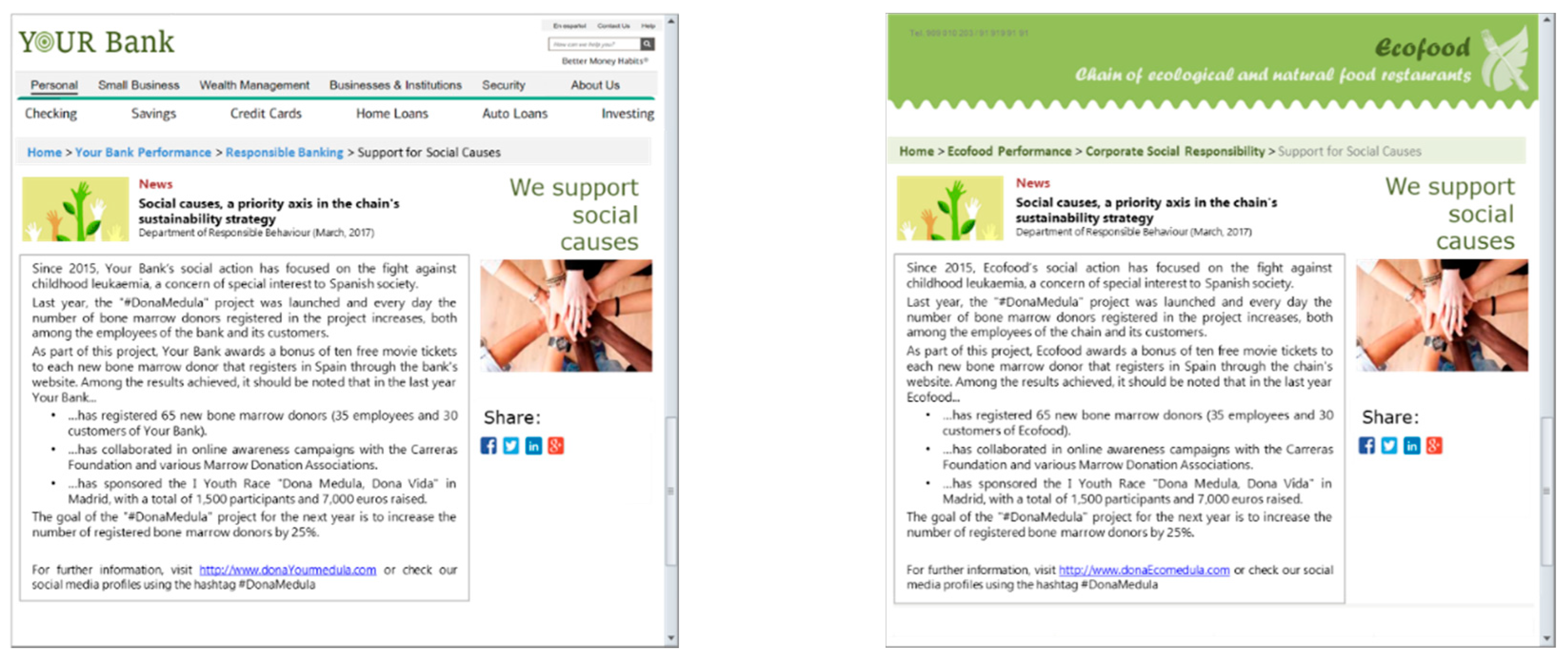
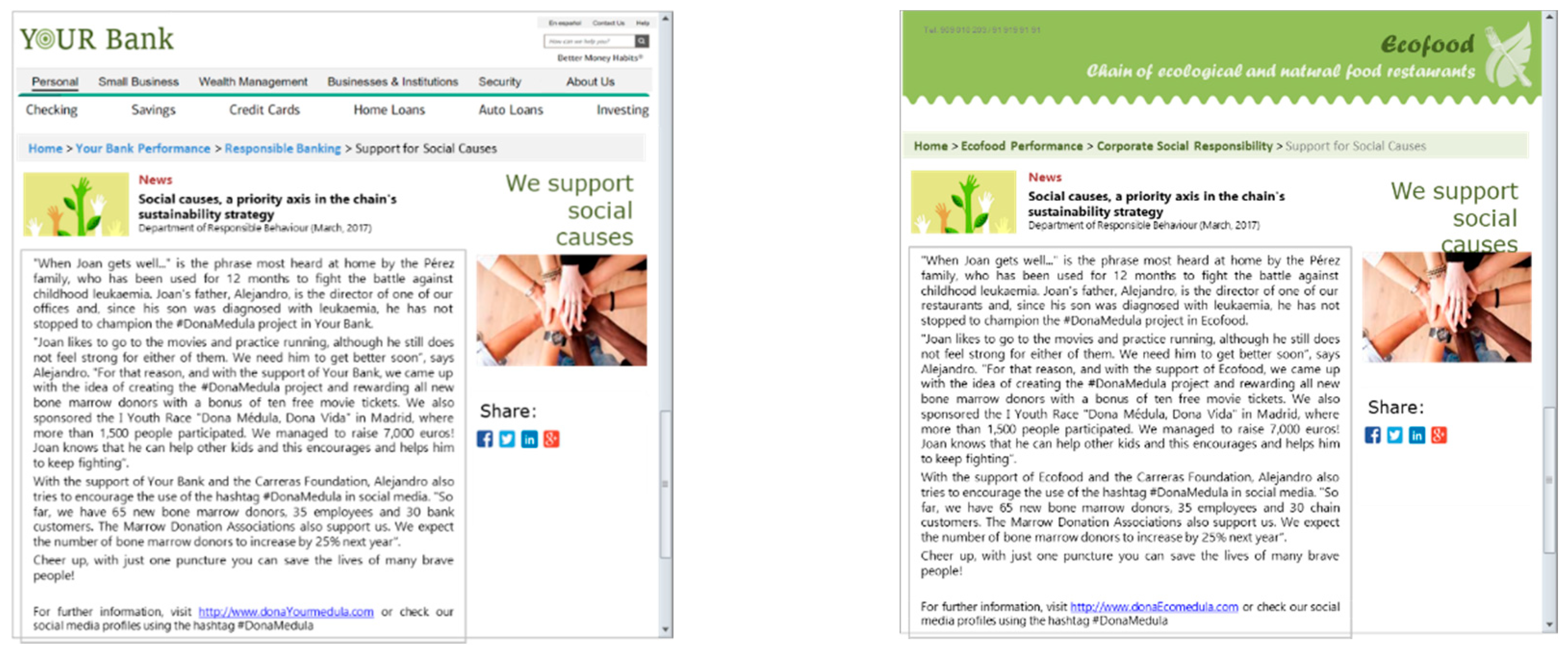
References
- Mason, C.; Simmons, J. Forward looking or looking unaffordable? Utilising academic perspectives on corporate social responsibility to assess the factors influencing its adoption by business. Bus. Ethics A Eur. Rev. 2011, 20, 159–176. [Google Scholar] [CrossRef]
- Liang, X.; Hu, X.; Meng, H. Truly sustainability or hypocrisy: The effects of corporate sustainable orientation on consumers’ quality perception and trust based on evidence from China. Sustainability 2020, 12, 2735. [Google Scholar] [CrossRef]
- Ahmed, I.; Nazir, M.S.; Ali, I.; Nurunnabi, M.; Khalid, A.; Shaukat, M.Z. Investing in CSR pays you back in many ways! The case of perceptual, attitudinal and behavioral outcomes of customers. Sustainability 2020, 12, 1158. [Google Scholar] [CrossRef]
- Du, S.; Bhattacharya, C.B.; Sen, S. Maximizing business returns to corporate social responsibility (CSR): The role of CSR communication. Int. J. Manag. Rev. 2010, 12, 8–19. [Google Scholar] [CrossRef]
- Skarmeas, D.; Leonidou, C.N. When consumers doubt, watch out! The role of CSR skepticism. J. Bus. Res. 2012, 66, 1831–1838. [Google Scholar] [CrossRef]
- Martin, J.; Powers, M. Organizational stories: More vivid and persuasive than quantitative data. In Psychological Foundations of Organizational Behavior; Foresman: Glenview, IL, USA, 1983; pp. 162–168. [Google Scholar]
- Weick, K.E.; Browning, L.D. Argument and narration in organizational communication. J. Manag. 1986, 12, 243–259. [Google Scholar] [CrossRef]
- Martin, J. Stories and scripts in organizational settings. In Cognitive Social Psychology; Elsevier: New York, NY, USA, 1982; pp. 255–305. [Google Scholar]
- Lewis, N.; Sznitman, S.R. You brought it on yourself: The joint effects of message type, stigma, and responsibility attribution on attitudes toward medical cannabis. J. Commun. 2017, 67, 181–202. [Google Scholar] [CrossRef]
- Murphy, S.T.; Frank, L.B.; Chatterjee, J.S.; Baezconde-Garbanati, L. Narrative versus nonnarrative: The role of identification, transportation and emotion in reducing health disparities. J. Commun. 2013, 63, 116–137. [Google Scholar] [CrossRef] [PubMed]
- Fisher, W.R. The narrative paradigm: An elaboration. Commun. Monogr. 1985, 52, 347–367. [Google Scholar] [CrossRef]
- Kaufman, B. Stories that sell, stories that tell. J. Bus. Strategy 2003, 24, 11–15. [Google Scholar] [CrossRef]
- Woodside, A.G. Brand-consumer storytelling theory and research: Introduction to a Psychology & Marketing speciall issue. Psychol. Mark. 2010, 27, 531–540. [Google Scholar]
- Lundqvist, A.; Liljander, V.; Gummerus, J.; van Riel, A. The impact of storytelling on the consumer brand experience: The case of a firm-originated story. J. Brand Manag. 2013, 20, 283–297. [Google Scholar] [CrossRef]
- Mortimer, K. Identifying the components of effective service advertisements. J. Serv. Mark. 2008, 22, 104–113. [Google Scholar] [CrossRef]
- Stafford, M.R.; Day, E. Retail services advertising: The effects of appeal, medium, and service. J. Advert. 1995, 24, 37–41. [Google Scholar] [CrossRef]
- Hill, D.J.; Blodgett, J.; Baer, R.; Wakefield, K. An investigation of visualization and documentation strategies in services advertising. J. Serv. Res. 2004, 7, 155–166. [Google Scholar] [CrossRef]
- Johar, J.S.; Sirgy, M.J. Value-expressive versus utilitarian advertising appeals: When and why to use which appeal. J. Advert. 1991, 20, 23–33. [Google Scholar] [CrossRef]
- Albers-Miller, N.D.; Stafford, M.R. International services advertising: An examination of variation in appeal use for experiential and utilitarian services. J. Serv. Mark. 1999, 13, 390–406. [Google Scholar] [CrossRef]
- Kempf, D.S. Attitude formation from product trial: Distinct roles of cognition and affect for hedonic and functional products. Psychol. Mark. 1999, 16, 35–50. [Google Scholar] [CrossRef]
- Andreu, L.; Casado-Díaz, A.B.; Mattila, A.S. Effects of message appeal and service type in CSR communication strategies. J. Bus. Res. 2015, 68, 1488–1495. [Google Scholar] [CrossRef]
- Yang, C.-M.; Hsu, T.-F. Effects of skepticism about corporate social responsibility advertising on consumer attitude. Soc. Behav. Pers. 2017, 45, 453–468. [Google Scholar] [CrossRef]
- Petty, R.E.; Cacioppo, J.T. Attitudes and Persuasion: Classic and Contemporary Approaches; William C. Brown: Dubuque, IO, USA, 1981. [Google Scholar]
- Singh, S.N.; Dalal, N.P. Web home pages as advertisements. Commun. ACM 1999, 42, 91–98. [Google Scholar] [CrossRef]
- Gill, R. An integrative review of storytelling: Using corporate stories to strengthen employee engagement and internal and external reputation. Prism 2011, 8, 1–16. [Google Scholar]
- Escalas, J.E. Narrative processing: Building consumer connections to brands. J. Consum. Psychol. 2004, 14, 168–180. [Google Scholar]
- Herskovitz, S.; Crystal, M. The essential brand persona: Storytelling and branding. J. Bus. Strategy 2010, 31, 21–28. [Google Scholar] [CrossRef]
- Zak, P.J. Why your brain loves good storytelling. Harv. Bus. Rev. 2014, 28, 1–5. [Google Scholar]
- Pérez, A.; del Mar García de los Salmones, M.; López-Gutiérrez, C. Corporate reputation in the Spanish context: An interaction between reporting to stakeholders and industry. J. Bus. Ethics 2015, 129, 733–746. [Google Scholar]
- Um, N.H. Revisit elaboration likelihood model: How advertising appeals work on attitudinal and behavioural brand loyalty centering around low vs. high involvement product. Eur. J. Soc. Sci. 2008, 7, 126–139. [Google Scholar]
- Jiang, Y.; Lu Wang, C. The impact of affect on service quality and satisfaction: The moderation of service contexts. J. Serv. Mark. 2006, 20, 211–218. [Google Scholar] [CrossRef]
- Sole, D.; Wilson, D.G. Storytelling in Organizations: The Power and Traps of Using Stories to Share Knowledge in Organizations; Harvard Graduate School of Education: Cambridge, MA, USA, 2002. [Google Scholar]
- Aldama, F.L. The Science of storytelling: Perspectives from cognitive science, neuroscience, and the humanities. Projections 2015, 9, 80–95. [Google Scholar] [CrossRef]
- Pérez, A.; del Mar García de los Salmones, M.; Liu, M.T. Maximising business returns to corporate social responsibility communication: An empirical test. Bus. Ethics A Eur. Rev. 2019, 28, 275–289. [Google Scholar]
- Pomering, A.; Johnson, L.W. Advertising corporate social responsibility initiatives to communicate corporate image: Inhibiting scepticism to enhance persuasion. Corp. Commun. An Int. J. 2009, 14, 420–439. [Google Scholar] [CrossRef]
- Menon, S.; Kahn, B. Corporate sponsorships of philanthropic activities: When do they impact perception of sponsor brand? J. Consum. Psychol. 2003, 13, 316–327. [Google Scholar] [CrossRef]
- Bhattacharya, C.B.; Korschun, D.; Sen, S. Strengthening stakeholder-company relationships through mutually beneficial corporate social responsibility initiatives. J. Bus. Ethics 2009, 85, 257–272. [Google Scholar] [CrossRef]
- Parguel, B.; Benoit-Moreau, F.; Larceneux, F. How sustainability ratings might deter “greenwashing”: A closer look at ethical corporate communication. J. Bus. Ethics 2011, 102, 15–28. [Google Scholar] [CrossRef]
- García de los Salmones, M.M.; Pérez, A. Effectiveness of CSR advertising: The role of reputation, consumer attributions, and emotions. Corp. Soc. Responsib. Environ. Manag. 2018, 25, 194–208. [Google Scholar] [CrossRef]
- van Rekom, J.; van Riel, C.B.M.; Wierenga, B. A methodology for assessing organizational core values. J. Manag. Stud. 2006, 43, 175–201. [Google Scholar] [CrossRef]
- Maignan, I.; Ralston, D.A. Corporate social responsibility in Europe and the U.S.: Insights from businesses’ self-presentations. J. Int. Bus. Stud. 2002, 33, 497–514. [Google Scholar] [CrossRef]
- Lafferty, B.A.; Goldsmith, R.E.; Hult, G.T.M. The impact of the alliance on the partners: A look at cause-brand alliances. Psychol. Mark. 2004, 21, 509–531. [Google Scholar] [CrossRef]
- Trimble, C.S.; Rifon, N.J. Consumer perceptions of compatibility in cause-related marketing messages. Int. J. Nonprofit Volunt. Sect. Mark. 2006, 11, 29–47. [Google Scholar] [CrossRef]
- Bigné, E.; Chumpitaz, R.; Currás, R. Alliances between brands and social causes: The influence of company credibility on social responsibility image. J. Bus. Ethics 2010, 96, 169–186. [Google Scholar]
- Rifon, N.J.; Choi, S.M.; Trimble, C.S.; Li, H. Congruence effect in sponsorship: The mediating role of sponsor credibility and consumer attributions of sponsor motive. J. Advert. 2004, 33, 29–42. [Google Scholar] [CrossRef]
- Benoit-Moreau, F.; Parguel, B. Building brand equity with environmental communication: An empirical investigation in France. EuroMed J. Bus. 2011, 6, 100–116. [Google Scholar] [CrossRef]
- Keller, K.L. Strategic Brand Management; Prentice-Hall: Upper Saddle River, NJ, USA, 1998. [Google Scholar]
- O’Cass, A.; Grace, D. Exploring consumer experiences with a service brand. J. Prod. Brand Manag. 2004, 13, 257–268. [Google Scholar] [CrossRef]
- Bravo, R.; Matute, J.; Pina, J.M. Corporate social responsibility as a vehicle to reveal the corporate identity: A study focused on the websites of Spanish financial entities. J. Bus. Ethics 2012, 107, 129–146. [Google Scholar] [CrossRef]
- Pérez, A.; del Mar García de los Salmones, M.; Rodríguez del Bosque, I. The effect of corporate associations on consumer behaviour. Eur. J. Mark. 2013, 47, 218–238. [Google Scholar]
- Garcia de los Salmones, M.M.; Perez, A.; Rodriguez del Bosque, I. The social role of financial companies as a determinant of consumer behaviour. Int. J. Bank Mark. 2009, 27. [Google Scholar] [CrossRef]
- Morgan, R.M.; Hunt, S.D. The commitment-trust theory of relationship marketing. J. Mark. 1994, 58, 20–38. [Google Scholar] [CrossRef]
- Chiou, J.-S.; Droge, C. Service quality, trust, specific asset investment, and expertise: Direct and indirect effects in a satisfaction-loyalty framework. J. Acad. Mark. Sci. 2006, 34, 613–627. [Google Scholar] [CrossRef]
- Lewis, B.R.; Soureli, M. The antecedents of consumer loyalty in retail banking. J. Consum. Behav. 2006, 5, 15–31. [Google Scholar] [CrossRef]
- Oliver, R.L. Satisfaction: A Behavioral Perspective on the Consumer; McGraw-Hill: New York, NY, USA, 1997. [Google Scholar]
- Oliver, R.L. Whence consumer loyalty? J. Mark. 1999, 63, 33–44. [Google Scholar] [CrossRef]
- Khan, Z.; Ferguson, D.; Pérez, A. Customer responses to CSR in the Pakistani banking industry. Mark. Intell. Plan. 2015, 33. [Google Scholar] [CrossRef]
- Westbrook, R.A. Product/consumption-based affective responses and postpurchase processes. J. Mark. Res. 1987, 24, 258–270. [Google Scholar] [CrossRef]
- Kim, Y. Strategic communication of corporate social responsibility (CSR): Effects of stated motives and corporate reputation on stakeholder responses. Public Relat. Rev. 2014, 40, 838–840. [Google Scholar] [CrossRef]
- Nan, X.; Heo, K. Consumer responses to Corporate Social Responsibility (CSR) initiatives: Examining the role of brand-cause fit in cause-related marketing. J. Advert. 2007, 36, 63–74. [Google Scholar] [CrossRef]
- Alniacik, U.; Alniacik, E.; Genc, N. How corporate social responsibility information influences stakeholders’ intentions. Corp. Soc. Responsib. Environ. Manag. 2011, 18, 234–245. [Google Scholar] [CrossRef]
- Currás, R. Comunicación de la Responsabilidad Social Corporativa: Imagen e Identificación con la Empresa como Antecedentes del Comportamiento del Consumidor; Universitat de València: Valencia, Spain, 2007. [Google Scholar]
- Ladhari, R.; Souiden, N.; Dufour, B. The role of emotions in utilitarian service settings: The effects of emotional satisfaction on product perception and behavioral intentions. J. Retail. Consum. Serv. 2017, 34, 10–18. [Google Scholar] [CrossRef]
- Chiu, H.-C.; Hsieh, Y.-C.; Kuo, Y.-C. How to align your brand stories with your products. J. Retail. 2012, 88, 262–275. [Google Scholar] [CrossRef]
- Mohr, L.A.; Eroǧlu, D.; Ellen, P.S. The development and testing of a measure of skepticism toward environmental claims in marketers’ communications. J. Consum. Aff. 1998, 32, 30–55. [Google Scholar] [CrossRef]
- Russell, D.W.; Russell, C.A. Here or there? Consumer reactions to corporate social responsibility initiatives: Egocentric tendencies and their moderators. Mark. Lett. 2010, 21, 65–81. [Google Scholar] [CrossRef]
- Connors, S.; Anderson-MacDonald, S.; Thomson, M. Overcoming the ‘window dressing’ effect: Mitigating the negative effects of inherent skepticism towards corporate social responsibility. J. Bus. Ethics 2017, 145, 599–621. [Google Scholar] [CrossRef]
- Becker-Olsen, K.L.; Cudmore, B.A.; Hill, R.P. The impact of perceived corporate social responsibility on consumer behavior. J. Bus. Res. 2006, 59, 46–53. [Google Scholar] [CrossRef]
- Speed, R.; Thompson, P. Determinants of sport sponsorship response. J. Acad. Mark. Sci. 2000, 28, 226–238. [Google Scholar] [CrossRef]
- Skard, S.; Thorbjørnsen, H. Is publicity always better than advertising? The role of brand reputation in communicating corporate social responsibility. J. Bus. Ethics 2014, 124, 149–160. [Google Scholar] [CrossRef]
- Walton, M.R. The PR in CSR: Assessing Perceptions of Partnerships Versus Donations in Corporate Social Responsibility Initiatives; Texas A&M University: Canyon, TX, USA, 2014. [Google Scholar]
- Wagner, T.; Lutz, R.J.; Weitz, B.A. Corporate hypocrisy: Overcoming the threat of inconsistent corporate social responsibility perceptions. J. Mark. 2009, 73, 77–91. [Google Scholar] [CrossRef]
- Groza, M.D.; Pronschinske, M.R.; Walker, M. Perceived organizational motives and consumer responses to proactive and reactive CSR. J. Bus. Ethics 2011, 102, 639–652. [Google Scholar] [CrossRef]
- Romani, S.; Grappi, S.; Bagozzi, R.P. Explaining consumer reactions to corporate social responsibility: The role of gratitude and altruistic values. J. Bus. Ethics 2013, 114, 193–206. [Google Scholar] [CrossRef]
- Podsakoff, P.M.; MacKenzie, S.B.; Lee, J.Y.; Podsakoff, N.P. Common method biases in behavioral research: A critical review of the literature and recommended remedies. J. Appl. Psychol. 2003, 88, 879–903. [Google Scholar] [CrossRef]
- Hair, J.F.; Black, W.C.; Babin, B.J.; Anderson, R.E. Multivariate Data Analysis, 7th ed.; Pearson Education Limited: Harlow, UK, 2014.
- Stafford, M.R. Tangibility in services advertising: An investigation of verbal versus visual cues. J. Advert. 1996, 25, 13–28. [Google Scholar] [CrossRef]
- Wakefield, K.L.; Inman, J.J. Situational price sensitivity: The role of consumption occasion, social context and income. J. Retail. 2003, 79, 199–212. [Google Scholar] [CrossRef]
- Forehand, M.R.; Grier, S. When is honesty the best policy? The effect of stated company intent on consumer skepticism. J. Consum. Psychol. 2003, 13, 349–356. [Google Scholar]
- Currás, R.; Bigné, E.; Alvarado, A. The role of self-definitional principles in consumer identification with a socially responsible company. J. Bus. Ethics 2009, 89, 547–564. [Google Scholar] [CrossRef]
- Delgado-Ballester, E.; Fernández-Sabiote, E. Once upon a brand: Storytelling practices by Spanish brands. Spanish J. Mark.-ESIC 2016, 20, 115–131. [Google Scholar] [CrossRef]
- Batra, R.; Ahtola, O.T. Measuring the hedonic and utilitarian sources of consumer attitudes. Mark. Lett. 1990, 2, 159–170. [Google Scholar] [CrossRef]
- van Laer, T.; de Ruyter, K.; Visconti, L.M.; Wetzels, M. The extended transportation-imagery model: A meta-analysis of the antecedents and consequences of consumers’ narrative transportation. J. Consum. Res. 2014, 40, 797–817. [Google Scholar] [CrossRef]
- Spear, S.; Roper, S. Using corporate stories to build the corporate brand: An impression management perspective. J. Prod. Brand Manag. 2013, 22, 491–501. [Google Scholar] [CrossRef]
- Du, S.; Vieira, E.T. Striving for legitimacy through corporate social responsibility: Insights from oil companies. J. Bus. Ethics 2012, 110, 413–427. [Google Scholar] [CrossRef]
- Gill, R. Why the PR strategy of storytelling improves employee engagement and adds value to CSR: An integrated literature review. Public Relat. Rev. 2015, 41, 662–674. [Google Scholar] [CrossRef]
- Bigné, E.; Currás, R.; Sánchez, I. Brand credibility in cause-related marketing: The moderating role of consumer values. J. Prod. Brand Manag. 2009, 18, 437–447. [Google Scholar] [CrossRef]
- Pérez, A.; del Bosque, I.R. How customer support for corporate social responsibility influences the image of companies: Evidence from the banking industry. Corp. Soc. Responsib. Environ. Manag. 2015, 22. [Google Scholar] [CrossRef]
- Hildebrand, D.; Demotta, Y.; Sen, S.; Valenzuela, A. Consumer responses to corporate social responsibility (CSR) contribution type. J. Consum. Res. 2017, 44, 738–758. [Google Scholar] [CrossRef]

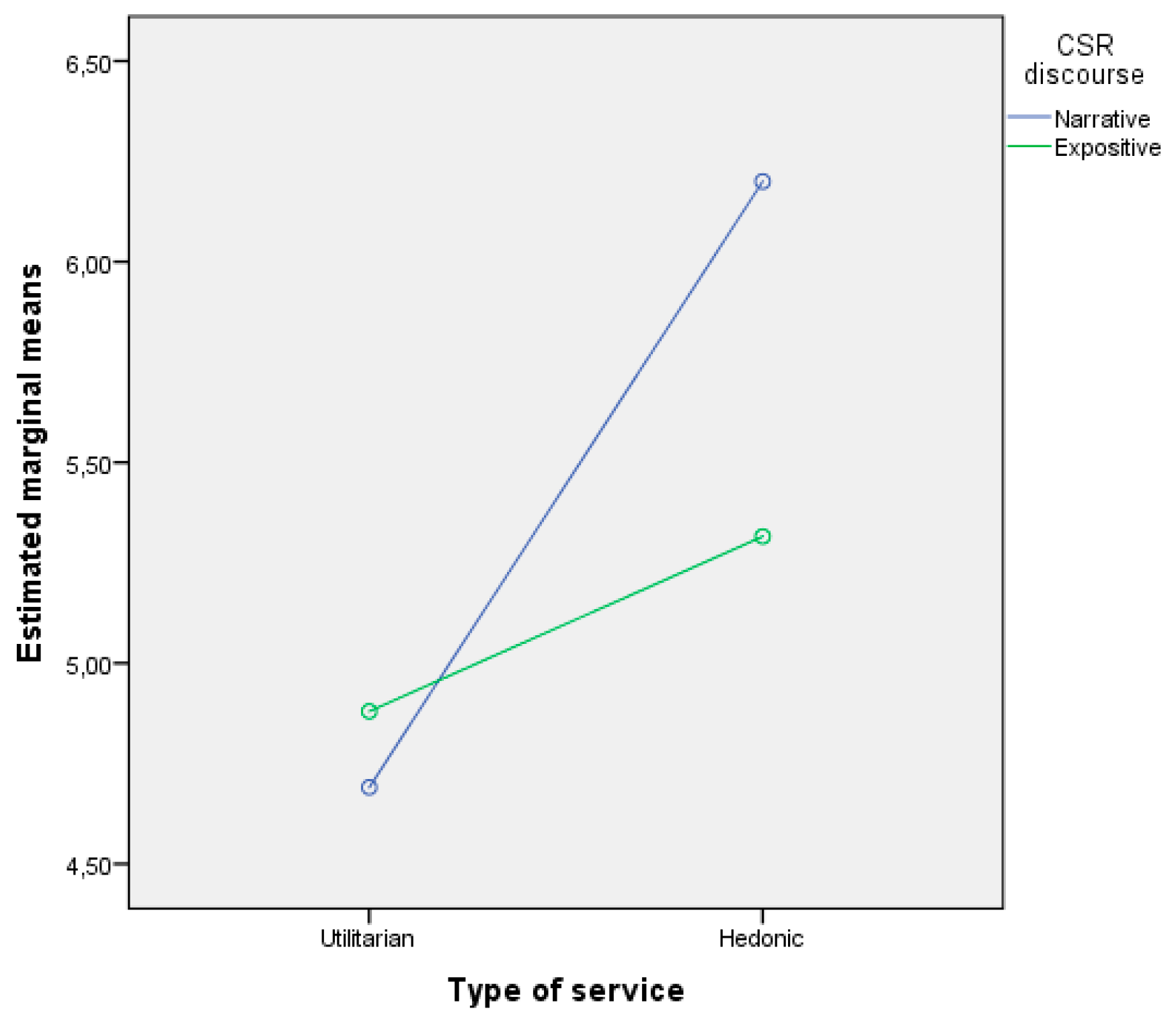
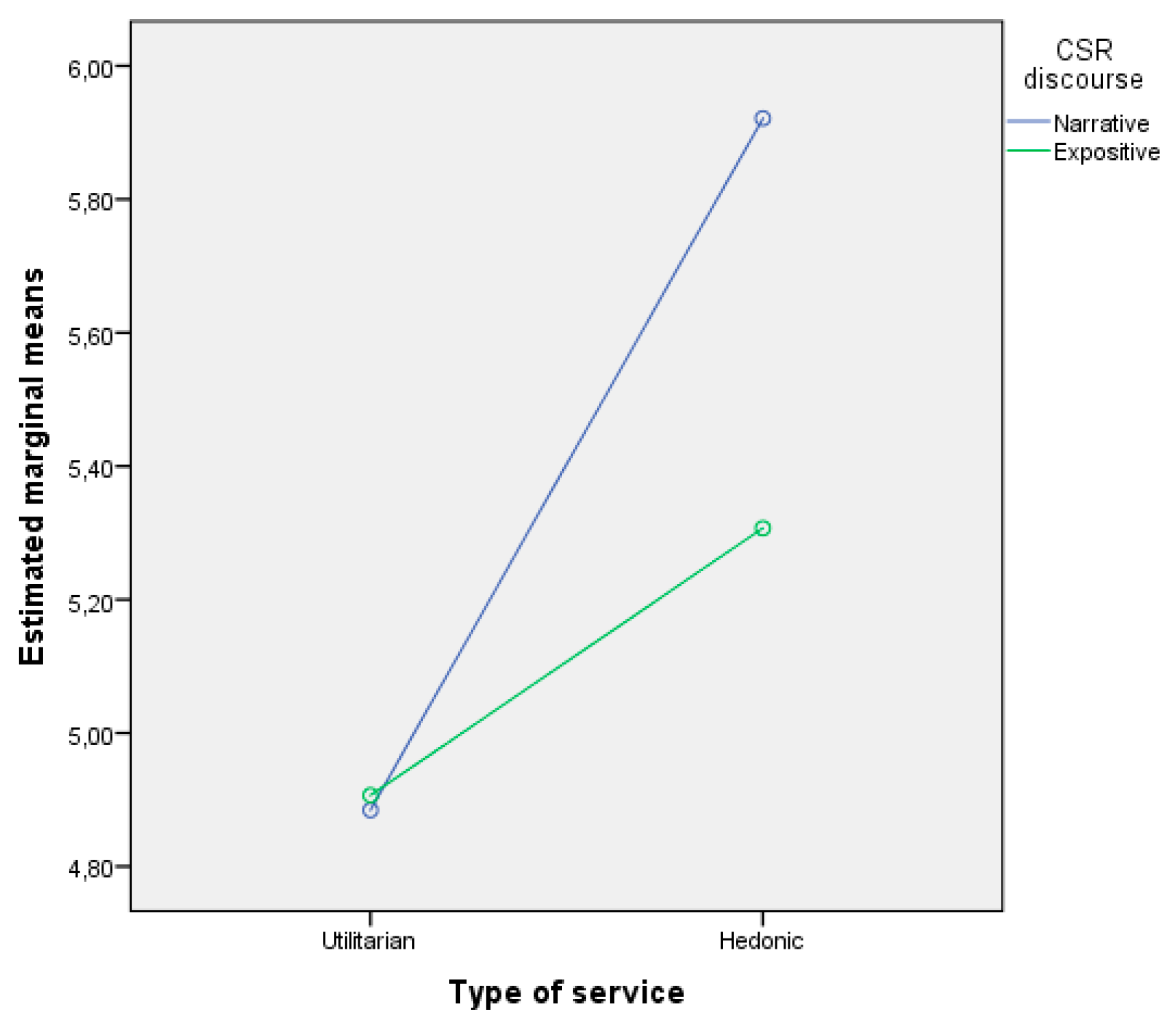
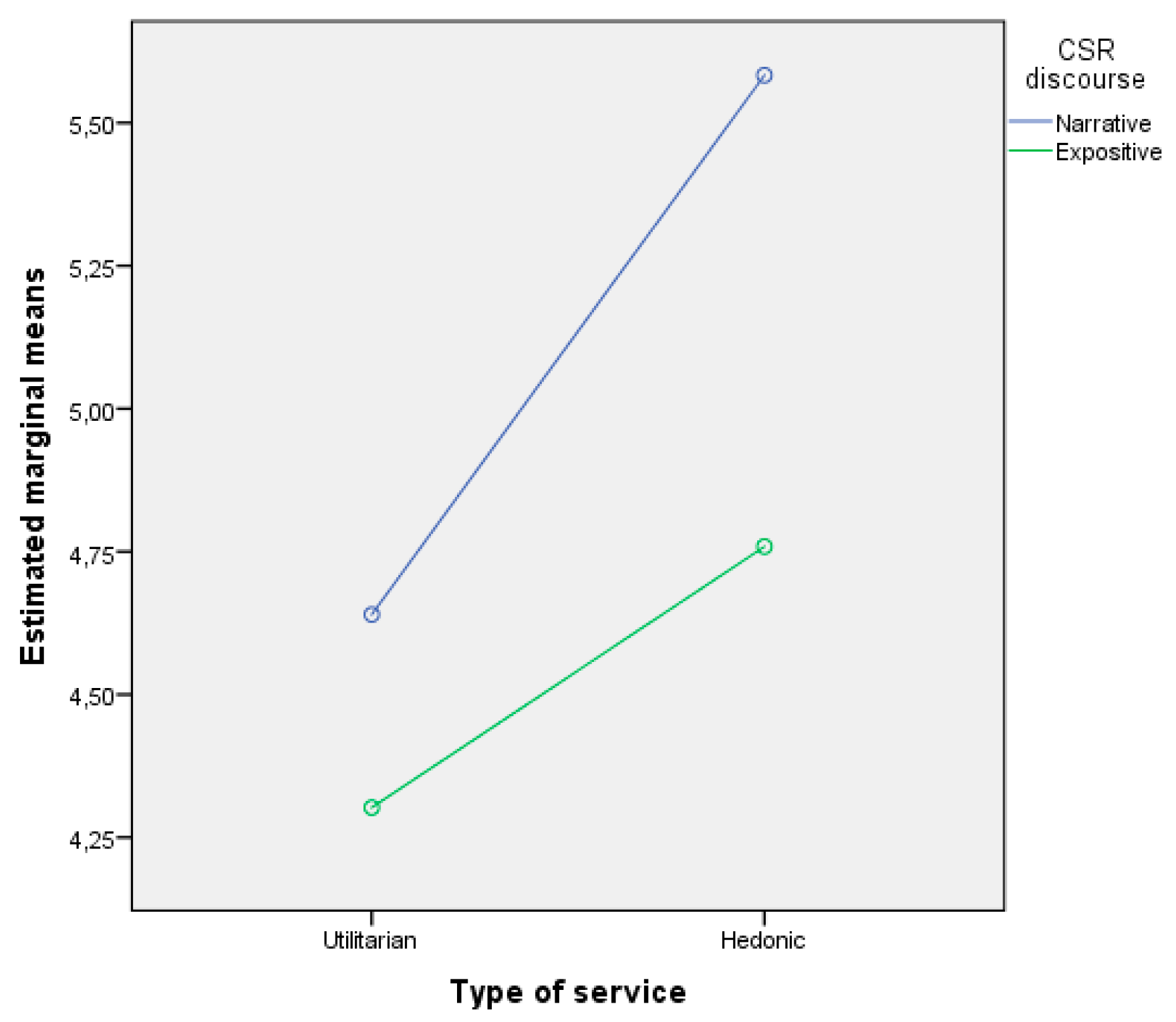
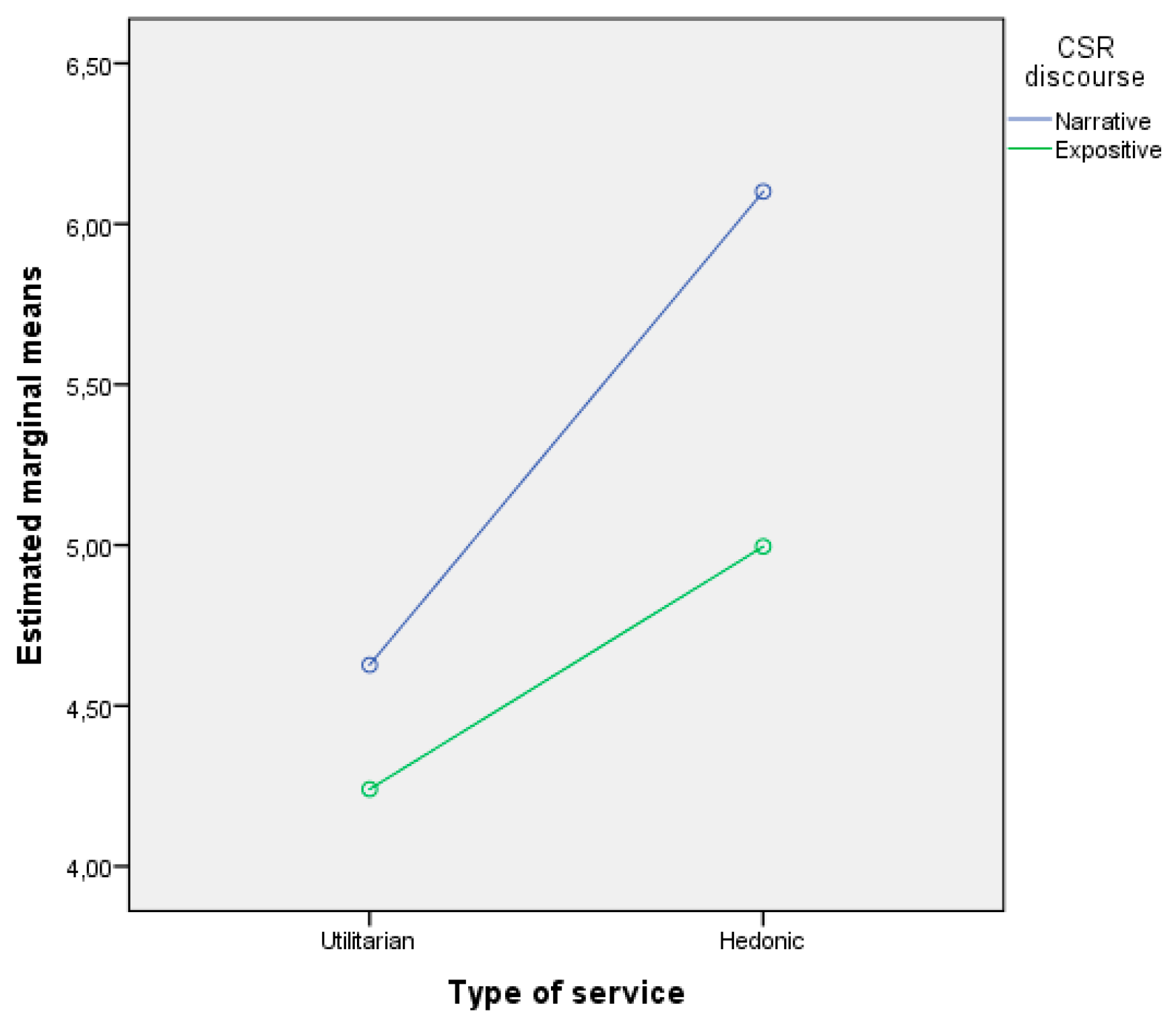
| Service Type | Discourse Strategy | n |
|---|---|---|
| Utilitarian (bank) | Expositive | 75 |
| Narrative | 75 | |
| Hedonic (restaurant) | Expositive | 76 |
| Narrative | 76 |
| Message Attributions | |
|---|---|
| Factors | Items |
| Issue importance | IMPO1) The company transmits that this is an important cause; IMPO2) The company transmits it is vital to tackle this cause; IMPO3) The company transmits that companies have a responsibility to address this cause |
| Impact | The information presented on the website is … IMPA1) Abstract/Concrete; IMPA2) Ambiguous/Clear; IMPA3) Not descriptive/Descriptive; IMPA4) Not vivid/Vivid; IMPA5) Not easy to imagine/Easy to imagine |
| Motives | The motivations of the company to support the cause are … MOTI1) Self-interested/Community interested; MOTI2) Firm-focused/Customer-focused; MOTI3) Profit-motivated/Socially-motivated |
| Fit | FIT1) The image of the cause and the image of the company are similar; FIT2) The company and the cause fit together well; FIT3) The company and the cause stand for similar things; FIT4) It makes sense to me that the company sponsors this cause; FIT5) There is a logical connection between the cause and the company |
| Commitment | COMM1) The company seems to feel strongly about helping the cause; COMM2) The company demonstrates a real interest in making an impact to help the cause; COMM3) The company is capable of long-lasting beneficial effects towards the cause; COMM4) The company seems like they will support the cause for a long period; COMM5) The company will more than likely make a large impact toward helping the cause |
| Consumer Responses | |
| Attributions | ATTR1) The company is socially responsible; ATTR2) The company is concerned to improve the well-being of society; ATTR3) The company follows high ethical standards |
| Attitude | My general feeling towards the company is … ATTI1) Unfavorable/Favorable; ATTI2) Bad/Good; ATTI3) Unpleasant/Pleasant; ATTI4) Negative/Positive |
| Identification | IDEN1) My way of being sticks with what I perceive from the company; IDEN2) I look like what I think the company represents; IDEN3) I am similar to how I perceive the company; IDEN4) The image I have of the company matches the image I have of myself; IDEN5) The company’s identity resembles my identity |
| Trust | TRUS1) The company can be trusted; TRUS2) The company can be counted on to do what is right; TRUS3) The company has high integrity |
| Purchase | If the company existed, how likely would it be that you purchased its services? ?PURC1) Very unlikely/Very likely; PURC2) Improbable/Probable; PURC3) Impossible/Possible |
| Advocacy | ADVO1) I intend to say positive things about the company to friends, relatives and other people; ADVO2) I intend to mention favorable things about the company with my friends, relatives, or other people; ADVO3) I intend to recommend to purchase services of the company to my friends, relatives, and other people |
| Factors | Items | Mean | s.d. | λ | R2 | CR | AVE |
|---|---|---|---|---|---|---|---|
| Issue importance | IMPO1 | 5.680 | 1.239 | 0.804 | 0.647 | 0.869 | 0.690 |
| IMPO2 | 5.520 | 1.296 | 0.904 | 0.817 | |||
| IMPO3 | 5.330 | 1.539 | 0.778 | 0.606 | |||
| CSR impact | IMPA1 | 5.320 | 1.245 | 0.816 | 0.666 | 0.875 | 0.584 |
| IMPA2 | 5.420 | 1.306 | 0.846 | 0.716 | |||
| IMPA3 | 4.940 | 1.376 | 0.757 | 0.573 | |||
| IMPA4 | 4.310 | 1.438 | 0.701 | 0.491 | |||
| IMPA5 | 5.010 | 1.396 | 0.689 | 0.475 | |||
| CSR motives | MOTI1 | 4.550 | 1.585 | 0.836 | 0.698 | 0.895 | 0.740 |
| MOTI2 | 4.640 | 1.548 | 0.812 | 0.659 | |||
| MOTI3 | 4.880 | 1.565 | 0.929 | 0.864 | |||
| CSR fit | FIT1 | 5.120 | 1.422 | 0.865 | 0.749 | 0.938 | 0.753 |
| FIT2 | 5.160 | 1.465 | 0.895 | 0.802 | |||
| FIT3 | 5.140 | 1.562 | 0.911 | 0.831 | |||
| FIT4 | 5.440 | 1.481 | 0.790 | 0.624 | |||
| FIT5 | 5.530 | 1.550 | 0.874 | 0.764 | |||
| CSR commitment | COMM1 | 5.350 | 1.285 | 0.633 | 0.400 | 0.869 | 0.574 |
| COMM2 | 5.240 | 1.295 | 0.705 | 0.497 | |||
| COMM3 | 4.830 | 1.309 | 0.763 | 0.582 | |||
| COMM4 | 4.800 | 1.404 | 0.830 | 0.689 | |||
| COMM5 | 5.070 | 1.370 | 0.836 | 0.699 |
| Factors | Items | Mean | s.d. | λ | R2 | CR | AVE |
|---|---|---|---|---|---|---|---|
| Attributions | ATTR1 | 5.250 | 1.319 | 0.855 | 0.731 | 0.857 | 0.667 |
| ATTR2 | 5.340 | 1.244 | 0.819 | 0.671 | |||
| ATTR3 | 5.180 | 1.300 | 0.775 | 0.600 | |||
| Attitude | ATTI1 | 5.360 | 1.246 | 0.880 | 0.774 | 0.951 | 0.828 |
| ATTI2 | 5.540 | 1.331 | 0.910 | 0.828 | |||
| ATTI3 | 5.530 | 1.375 | 0.946 | 0.894 | |||
| ATTI4 | 5.590 | 1.348 | 0.902 | 0.814 | |||
| Identification | IDEN1 | 4.750 | 1.375 | 0.802 | 0.643 | 0.945 | 0.777 |
| IDEN2 | 4.620 | 1.373 | 0.892 | 0.795 | |||
| IDEN3 | 4.540 | 1.475 | 0.934 | 0.873 | |||
| IDEN4 | 4.420 | 1.502 | 0.903 | 0.815 | |||
| IDEN5 | 4.380 | 1.509 | 0.870 | 0.758 | |||
| Trust | TRUS1 | 4.630 | 1.318 | 0.852 | 0.726 | 0.894 | 0.739 |
| TRUS2 | 4.900 | 1.210 | 0.875 | 0.766 | |||
| TRUS3 | 4.940 | 1.242 | 0.851 | 0.724 | |||
| Purchase | PURC1 | 4.750 | 1.412 | 0.859 | 0.738 | 0.937 | 0.832 |
| PURC2 | 4.670 | 1.599 | 0.963 | 0.928 | |||
| PURC3 | 4.770 | 1.613 | 0.912 | 0.832 | |||
| Advocacy | ADVO1 | 5.030 | 1.579 | 0.952 | 0.906 | 0.957 | 0.882 |
| ADVO2 | 5.070 | 1.573 | 0.968 | 0.937 | |||
| ADVO3 | 4.880 | 1.624 | 0.896 | 0.803 |
| Factors | Type of Service (S) | Discourse Strategy (D) | Interaction (S x D) | ||||
|---|---|---|---|---|---|---|---|
| Mean (U) | Mean (H) | F (p) | Mean (E) | Mean (N) | F (p) | ||
| Issue importance | 5.202 | 5.809 | 21.258 (0.000) | 5.351 | 5.665 | 5.579 (0.019) | 8.228 (0.004) |
| CSR impact | 4.845 | 5.155 | 6.337 (0.012) | 4.744 | 5.258 | 17.419 (0.000) | 0.003 (0.953) |
| CSR motives | 4.331 | 5.050 | 20.861 (0.000) | 4.539 | 4.848 | 3.884 (0.059) | 1.624 (0.203) |
| CSR fit | 4.785 | 5.758 | 47.898 (0.000) | 5.099 | 5.450 | 6.113 (0.014) | 14.590 (0.000) |
| CSR commitment | 4.812 | 5.303 | 16.215 (0.000) | 4.958 | 5.160 | 2.762 (0.098) | 0.038 (0.845) |
| Attributions | 4.896 | 5.614 | 34.802 (0.000) | 5.108 | 5.406 | 5.903 (0.016) | 6.823 (0.009) |
| Attitude | 4.970 | 6.026 | 68.856 (0.000) | 5.328 | 5.676 | 7.414 (0.007) | 1.579 (0.210) |
| Identification | 4.311 | 4.766 | 9.217 (0.003) | 4.522 | 4.558 | 0.054 (0.817) | 1.140 (0.287) |
| Trust | 4.471 | 5.171 | 33.888 (0.000) | 4.532 | 5.115 | 23.363 (0.000) | 4.098 (0.044) |
| Purchase | 4.396 | 5.061 | 16.998 (0.000) | 4.528 | 4.934 | 6.313 (0.013) | 0.134 (0.715) |
| Advocacy | 4.433 | 5.548 | 50.338 (0.000) | 4.620 | 5.369 | 22.534 (0.000) | 5.228 (0.023) |
© 2020 by the authors. Licensee MDPI, Basel, Switzerland. This article is an open access article distributed under the terms and conditions of the Creative Commons Attribution (CC BY) license (http://creativecommons.org/licenses/by/4.0/).
Share and Cite
Pérez, A.; García de los Salmones, M.d.M.; Baraibar-Diez, E. Effects of the Type of CSR Discourse for Utilitarian and Hedonic Services. Sustainability 2020, 12, 4821. https://doi.org/10.3390/su12124821
Pérez A, García de los Salmones MdM, Baraibar-Diez E. Effects of the Type of CSR Discourse for Utilitarian and Hedonic Services. Sustainability. 2020; 12(12):4821. https://doi.org/10.3390/su12124821
Chicago/Turabian StylePérez, Andrea, María del Mar García de los Salmones, and Elisa Baraibar-Diez. 2020. "Effects of the Type of CSR Discourse for Utilitarian and Hedonic Services" Sustainability 12, no. 12: 4821. https://doi.org/10.3390/su12124821
APA StylePérez, A., García de los Salmones, M. d. M., & Baraibar-Diez, E. (2020). Effects of the Type of CSR Discourse for Utilitarian and Hedonic Services. Sustainability, 12(12), 4821. https://doi.org/10.3390/su12124821







